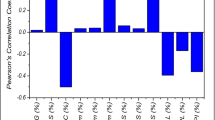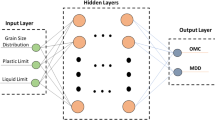Abstract
The present study focused on developing the multi-layer perceptron neural network prediction model for the modified compaction parameters of coarse-grained and fine-grained soil. A total of 248 in situ collected soil samples were taken from the ongoing highways construction project work site for their quality control purposes. The collected soil samples were tested in the laboratory using Bureau of Indian Standard specification. Among 248 datasets, 179 datasets belong to coarse-grained soil, and the remaining 69 datasets are fit for fine-grained soil. The artificial neural network (ANN) algorithm, written in Python V3.7.9 platform, was adopted for the model development. The developed model exhibits the correlation coefficient (R) value more than 0.80 and 0.90 for coarse-grained and fine-grained soil, respectively. Additionally, the selected ANN models can predict MDD within ± 4% and ± 2% variations for coarse-grained and fine-grained soil, respectively. In contrast, OMC for both the soil can be predicted within ± 8% variations.














Similar content being viewed by others
References
Ardakani A, Kordnaeij A (2017) Soil compaction parameters prediction using GMDH-type neural network and genetic algorithm. Eur J Environ Civ Eng 23:1–14
Bardhan A, Gokceoglu C, Burman A, Samui P, Asteris PG (2021) Efficient computational techniques for predicting the California bearing ratio of soil in soaked conditions. Eng Geol 291:106239
Bardhan A, Samui P, Ghosh K, Gandomi AH, Bhattacharyya S (2021) ELM-based adaptive neuro swarm intelligence techniques for predicting the California bearing ratio of soils in soaked conditions. Appl Soft Comput 110:107595
Bera A, Ghosh A (2011) Regression model for prediction of optimum moisture content and maximum dry unit weight of fine grained soil. Int J Geotech Eng 5(3):297–305
Das SK (2005) Application of genetic algorithm and artificial neural network to some geotechnical engineering problems. Ph.D Thesis, IIT Kanpur, India
Das SK (2013) Artificial neural networks in geotechnical engineering: modeling and application issues. Metaheuristics Water Geotech Transp Eng 45:231–267
Das SK, Basudhar PK (2006) Undrained lateral load capacity of piles in clay using artificial neural network. Comput Geotech 33(8):454–459
Das SK, Samui P, Sabat AK (2011) Application of artificial intelligence to maximum dry density and unconfined compressive strength of cement stabilized soil. Geotech Geol Eng 29(3):329–342
Di Matteo L, Bigotti F, Ricco R (2009) Best-fit models to estimate modified proctor properties of compacted soil. J Geotech Geoenviron Eng 135(7):992–996
Erzin Y, Turkoz D (2016) Use of neural networks for the prediction of the CBR value of some Aegean sands. Neural Comput Appl 27(5):1415–1426
Farooq K, Khalid U, Mujtaba H (2016) Prediction of compaction characteristics of fine-grained soils using consistency limits. Arab J Sci Eng 41(4):1319–1328
Günaydın O (2009) Estimation of soil compaction parameters by using statistical analyses and artificial neural networks. Environ Geol 57(1):203
Gunaydin O, Gokoglu A, Fener M (2010) Prediction of artificial soil’s unconfined compression strength test using statistical analyses and artificial neural networks. Adv Eng Softw 41(9):1115–1123
Gurtug Y, Sridharan A (2004) Compaction behaviour and prediction of its characteristics of fine grained soils with particular reference to compaction energy. Soils Found 44(5):27–36
Gurtug Y, Sridharan A, Ikizler SB (2018) Simplified method to predict compaction curves and characteristics of soils. Iran J Sci Technol Trans Civ Eng 42(3):207–216
Jalal FE, Xu Y, Iqbal M, Jamhiri B, Javed MF (2021) Predicting the compaction characteristics of expansive soils using two genetic programming-based algorithms. Transp Geotech 30:100608
Karimpour-Fard M, Machado SL, Falamaki A, Carvalho MF, Tizpa P (2019) Prediction of compaction characteristics of soils from index test’s results. Iran J Sci Technol Trans Civ Eng 43(1):231–248
Khandelwal M, Singh TN (2009) Prediction of blast-induced ground vibration using artificial neural network. Int J Rock Mech Min Sci 46(7):1214–1222
Khuntia S, Mujtaba H, Patra C, Farooq K, Sivakugan N, Das BM (2015) Prediction of compaction parameters of coarse grained soil using multivariate adaptive regression splines (MARS). Int J Geotech Eng 9(1):79–88
Kolay E, Baser T (2014) Estimating of the dry unit weight of compacted soils using general linear model and multi-layer perceptron neural networks. Appl Soft Comput 18:223–231
Kurnaz TF, Kaya Y (2020) The performance comparison of the soft computing methods on the prediction of soil compaction parameters. Arab J Geosci 13(4):159
Mishra AK, Kumar B, Vadlamudi S (2017) Prediction of hydraulic conductivity for soil–bentonite mixture. Int J Environ Sci Technol 14(8):1625–1634
Omar M, Shanableh A, Basma A, Barakat S (2003) Compaction characteristics of granular soils in United Arab Emirates. Geotech Geol Eng 21(3):283–295
Patra C, Sivakugan N, Das B (2010) Relative density and median grain-size correlation from laboratory compaction tests on granular soil. Int J Geotech Eng 4(1):55–62
Proctor RR (1933) Fundamental principles of soil compaction. Eng News Rec 111(13)
Rafiq MY, Bugmann G, Easterbrook DJ (2001) Neural network design for engineering applications. Comput Struct 79(17):1541–1552
Sabat AK (2015) Prediction of California bearing ratio of a stabilized expansive soil using artificial neural network and support vector machine. Electron J Geotech Eng 20(3):981–991
Shahin MA, Jaksa MB, Maier HR (2001) Artificial neural network applications in geotechnical engineering. Aust Geomech 36(1):49–62
Shahin MA, Jaksa MB, Maier HR (2008) State of the art of artificial neural networks in geotechnical engineering. Electron J Geotech Eng 8:1–26
Shahin MA, Maier HR, Jaksa MB (2004) Data division for developing neural networks applied to geotechnical engineering. J Comput Civ Eng 18(2):105–114
Shukla D, Solanki CH (2020) Estimated empirical correlations between shear wave velocity and SPT-N value for indore City using NLR and ANN. Indian Geotech J 50:1–17
Taha OME, Majeed ZH, Ahmed SM (2018) Artificial neural network prediction models for maximum dry density and optimum moisture content of stabilized soils. Transp Infrastruct Geotechnol 5(2):146–168
Tenpe AR, Patel A (2018) Application of genetic expression programming and artificial neural network for prediction of CBR. Road Mater Pavement Des 21(5):1183–1200
Tenpe AR, Patel A (2020) Utilization of support vector models and gene expression programming for soil strength modeling. Arab J Sci Eng 45:1–19
Verma G, Kumar B (2019) Prediction of compaction parameters for fine-grained and coarse-grained soils: a review. Int J Geotech Eng. https://doi.org/10.1080/19386362.2019.1595301
Wang H-L, Yin Z-Y (2020) High performance prediction of soil compaction parameters using multi expression programming. Eng Geol 276:105758
Yang X-S, Gandomi AH, Talatahari S, Alavi AH (2012) Metaheuristics in water, geotechnical and transport engineering. Newnes, London
Author information
Authors and Affiliations
Corresponding author
Ethics declarations
Conflict of interest
No potential conflict of interest was reported by the authors.
Rights and permissions
About this article
Cite this article
Verma, G., Kumar, B. Multi-layer perceptron (MLP) neural network for predicting the modified compaction parameters of coarse-grained and fine-grained soils. Innov. Infrastruct. Solut. 7, 78 (2022). https://doi.org/10.1007/s41062-021-00679-7
Received:
Accepted:
Published:
DOI: https://doi.org/10.1007/s41062-021-00679-7




